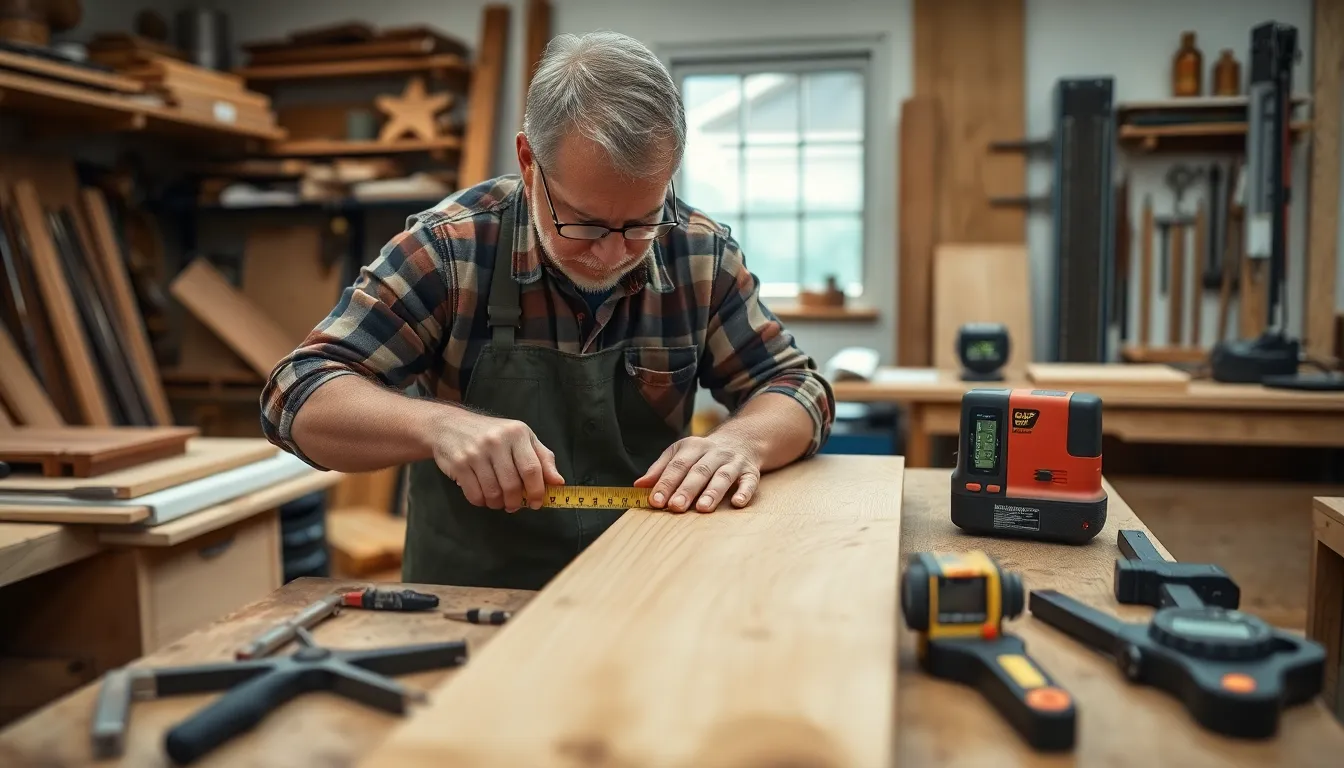In the world of workshops, measuring tools are the unsung heroes, quietly saving the day while wielding their magical powers of precision. Without them, projects could turn into a game of “guess and hope for the best,” and nobody wants to end up with a coffee table that doubles as a modern art installation.
Table of Contents
ToggleOverview of Measuring Tools in Workshop
Measuring tools play a crucial role in achieving accuracy in workshop projects. These instruments enable craftsmen to make sure all dimensions align with specifications. Common tools include tape measures, calipers, and squares. Each tool serves a specific purpose, enhancing the overall quality of work.
Tape measures provide handy flexibility, allowing for measurements across larger spaces. Digital calipers offer precise readings critical for smaller components. Squares assist in verifying right angles, ensuring cuts are straight and true. Using these tools together can significantly reduce errors during assembly.
In addition to those, laser distance measurers are gaining popularity. These devices deliver quick measurements, eliminating the need for manual calculations. As projects grow in complexity, so does the importance of reliable tools. Accuracy directly influences the integrity of final products, making it essential for professionals and hobbyists alike.
Craftsmanship improves when using calibrated tools regularly. Regularly checking instruments for accuracy ensures reliable results. Workers should also keep tools clean and well-maintained to prolong their lifespan. Observing these practices leads to greater efficiency in the workshop.
A variety of measuring tools exists, offering diverse options for different needs. Understanding the unique applications of each instrument is key. Thoughtful selection of measuring tools enhances project outcomes. Prioritizing precision tools creates a foundation upon which excellent craftsmanship is built.
Types of Measuring Tools

Measuring tools play a critical role in workshops, ensuring accuracy and precision. Various types of measuring tools cater to different aspects of measurement.
Linear Measurement Tools
Tape measures serve as fundamental linear measurement tools, widely used for measuring lengths and distances. Rulers offer similar functionality, providing straight edges for marking and measuring small dimensions. Calipers excel at measuring internal and external dimensions, delivering precise readings for intricate parts. Digital measuring devices, like laser distance measurers, enhance convenience by offering quick measurements over larger distances. Each tool contributes uniquely to achieving precise dimensions, reducing the likelihood of errors in crafting projects.
Circular Measurement Tools
Circular measurement tools focus on measuring curved surfaces and diameters. Pi tape specifically measures the circumference of round objects, allowing straightforward diameter calculation. Radius gauges help verify the size of arcs when precision is crucial. The use of calipers can extend to circular objects, particularly for measuring inside and outside diameters. Utilizing these tools ensures accurate measurement of circular elements, thereby enhancing the overall quality of design and assembly.
Angle Measurement Tools
Angle measurement tools include protractors and digital angle finders, essential for achieving correct angles in designs. Protractors enable craftsmen to measure and draw angles quickly, a vital function in woodworking and metalworking. Digital angle finders provide precise angle measurements electronically, eliminating human error during setup. Triangles also serve a purpose, aiding in the creation of right angles and angled cuts. These tools collectively ensure that projects meet specific design requirements, delivering quality outcomes in finished products.
Essential Measuring Tools for Every Workshop
Measuring tools play a crucial role in ensuring precision and quality in any workshop. Various tools serve distinct purposes, enhancing overall craftsmanship.
Tape Measure
A tape measure stands as one of the most versatile linear measuring tools. It features a flexible blade that can easily coil for storage. Most tape measures extend from 12 to 30 feet, accommodating various project sizes. Many craftsmen rely on tape measures for quick and accurate distance measurement. The large, easy-to-read markings allow for precise readings and help prevent errors in cuts or placements. Additionally, some models include magnetic tips for convenience when measuring against metal surfaces.
Calipers
Calipers provide an accurate means to measure small dimensions and depths. With options like digital or dial displays, they ensure clear readings. Commonly, calipers measure inside, outside, and depth dimensions with precision down to millimeters. Using calipers, craftsmen can achieve accurate measurements for intricate tasks, such as fitting vehicle parts or checking the thickness of materials. Regular calibration maintains their reliability, ensuring consistent performance throughout projects.
Rulers and Squares
Rulers and squares function as essential tools for creating straight lines and right angles. Rulers typically measure up to 36 inches, facilitating precise length measurements on flat surfaces. On the other hand, squares, including framing squares and try squares, help craft accurate right angles in various projects. Both tools prove invaluable for marking guidelines before cuts, enabling cleaner and more precise workmanship. Maintaining these tools in optimal condition ensures their accuracy reflects in the final product.
Specialized Measuring Tools
Specialized measuring tools enhance precision and accuracy in workshop tasks. These instruments play significant roles in obtaining reliable measurements.
Micrometers
Micrometers excel at measuring small dimensions with high accuracy. These tools feature a calibrated screw mechanism allowing measurements down to 0.001 inches or 0.01 millimeters. Craftsmen commonly use micrometers to assess the thickness of materials, such as metal or wood. Each tool offers specific types, including outside, inside, and depth micrometers, catering to different measurement needs. Digital micrometers provide easy-to-read displays, while traditional models use analog scales. Ensuring micrometers remain clean and properly calibrated is crucial for maintaining their accuracy over time.
Levels
Levels guarantee horizontal and vertical alignments in projects. Traditional bubble levels use liquid-filled vials to indicate when a surface is level. Magnetic levels also offer easy attachment to metal surfaces, allowing for precise measurement during installation tasks. Digital levels provide a numeric readout, enhancing usability and reducing interpretation errors. Various sizes accommodate different projects, from small crafts to larger constructions. Regular maintenance, including wiping clean and ensuring the vials remain undamaged, helps preserve their functionality.
Measuring tools are indispensable in any workshop. Their role in ensuring accuracy and precision can’t be overstated. By incorporating a variety of tools like tape measures calipers and levels craftsmen can elevate their work quality significantly.
Regular maintenance and calibration of these instruments are crucial for reliable results. Whether tackling a simple project or a complex design the right measuring tools make all the difference. Investing time in understanding and utilizing these tools effectively leads to enhanced craftsmanship and successful outcomes in every project.


